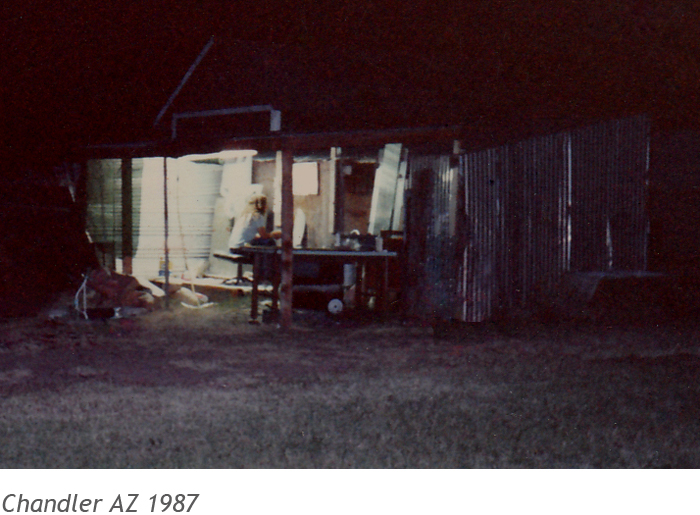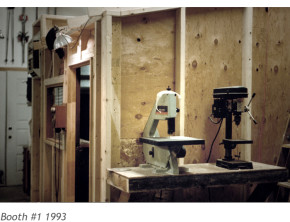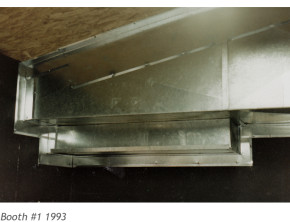 Actually, in the beginning there was no booth. At the studio where I had first been employed as a glass artist, I had worked outdoors in a vacant lot. They had been doing it there for I don’t know how many years, and so it was like standing amongst blinding white dunes of silica. Thinking back on it has that same surreal quality as remembering that there was a time when people smoked aboard commercial airline flights or while shopping for groceries – just doesn’t seem real but it was, you know?
Actually, in the beginning there was no booth. At the studio where I had first been employed as a glass artist, I had worked outdoors in a vacant lot. They had been doing it there for I don’t know how many years, and so it was like standing amongst blinding white dunes of silica. Thinking back on it has that same surreal quality as remembering that there was a time when people smoked aboard commercial airline flights or while shopping for groceries – just doesn’t seem real but it was, you know?
The other place where I was blasting back then was under a roof attached to an old shed, but still basically without walls. I came across this photo from 1987 that shows me working at night out behind a place I was renting in Chandler Arizona. I was also using the inside of the shed for building stained glass windows. As enjoyable as it can be to work outside, there are many disadvantages to deal with, such as the little gifts that cats leave for you in your sand.
The next time I was setting up, I decided it was time to make some changes. I thought I should get out of the weather, get less noisy, and although silica sand was dirt cheap, I still wanted to contain and recycle it. By the way, for those of you that may be wanting to become sandblasters, do NOT use silica sand. Even though you really shouldn’t breathe large amounts of any abrasive, some are worse than others. It’s probably not a good idea to use one that has its own disease named for it (silicosis). After a few years I switched to aluminum oxide and still take many precautions to avoid breathing it.
Anyway, I needed to build something, but remember, this was the olden days, before “google”and I had no one to consult with, no example to work from. I doubt I had even ever heard of the term sandblast booth. It seemed simple enough though; it was to be a structure big enough to lean a piece of glass in, and to be able to sit or stand comfortably in front of it. Air needed to move through it. Large particles needed to stay, small needed to leave and be collected elsewhere. There needed to be lots of light. Not much more to it right?
We had an over-sized two car garage that had an area which seemed ideal. There was a swamp cooler mounted outside one of the exterior walls at just above eye level which was just blowing air straight in through a hole in the wall. I built the booth right in front of the hole and brought the air through to the front of the booth via a metal box.
The metal box had a sliding panel that could drop however much air I wanted into the booth, or could be slid shut so that the maximum amount of air could be cooling the garage. Those of you that know anything about this stuff will see I was already going in the wrong direction.
There are two ways to move air through a sandblast booth; pushing and pulling. Only one of those ways is the right way. I think when people go about taking on the task without any prior experience or don’t have the benefit of any guidance, they will most often choose the wrong way, without even thinking twice about it. It seems the natural choice because when we use a fan to move air in our everyday lives, we don’t really ever point them AWAY from us in order to cool off.
The only way blowing air into the booth works out well at all is if the air is then allowed to exit an unrestricted hole, in other words – no filters … but who would do that in this day an age? The moment any kind of filter enters the picture the problems begin. The air inside the booth becomes pressurized. The pressurized air of course goes wherever it is easiest to go. Question: which is the path of least resistance, a filter … or the crack under the door? That’s right! EVERYTHING has to be sealed completely!
Even if you do actually manage to absolutely seal it up, the problems don’t end there. Air that is being pushed into the space at a considerable velocity is then expected to exit through a filter that cannot help but to slow it down. The incoming air isn’t going to stroll up and wait in line at the filter, it’s going to find something else to do until it loses enough speed to take its turn. It races around for a while and so what you end up with is a continuously stirred fog that gets worse and worse as the filter becomes more and more restrictive with every passing moment. The more restrictive it becomes, the farther the dust shoots out the little holes that you have failed to seal up, effectively dusting your entire workplace so badly you begin to wonder why you even built a booth at all.
For as much that is wrong about pushing air in, there is all the more that is right about pulling it out. Air is now trying to get in everywhere it can, so technically you don’t really have to worry so much about sealing it up. Before I get into that, I should mention the second sandblast booth I worked in, which fell into a third category. Air was neither pushed in OR pulled out, instead it hung in a stagnant cloud around a non-functional bag style collector that had been plopped right inside the booth. Think about that. INSIDE the booth. Believe me, it was better to not even turn the thing on. I didn’t have anything to do with the design or construction of that booth, but for simplicity’s sake I’m going to call it booth#2. Luckily I only had to work in it briefly – the company was about to re-locate, and I had been hired on just in time to build booth#3 – which will be the next subject in this multi-post series.

